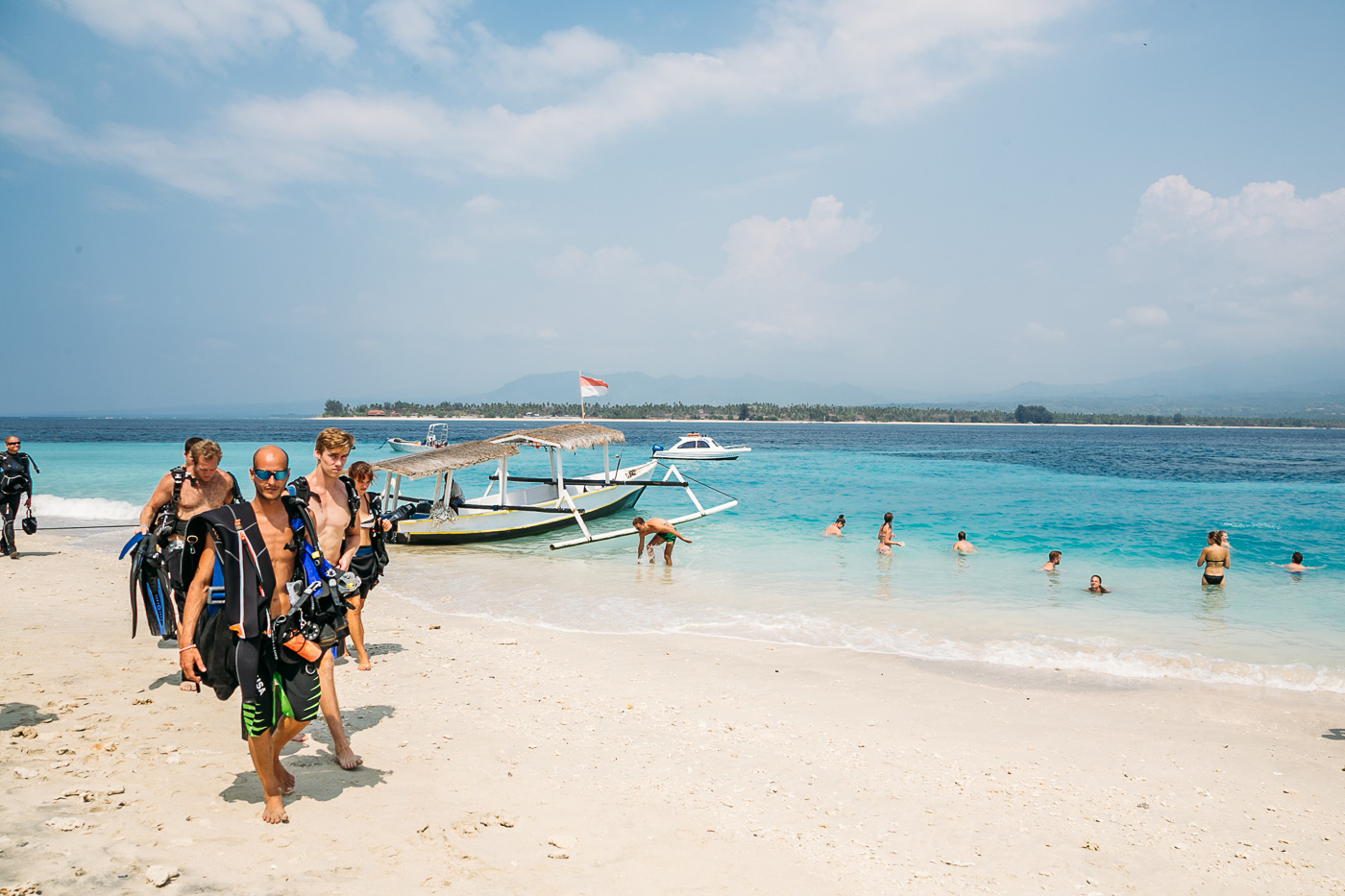Gili Air sits only 45 kilometers off the northwestern coast of Lombok, Indonesia. It is the closest to mainland in a row of three sister islands, but feels like it might as well be another universe. There are no gas guzzling vehicles allowed. Only a few electric motorbikes and horse drawn carriages to navigate the narrow dirt roads, none more than a few meters wide. Bikes and your own two feet are still the predominate way to get around. Tourism definitely prevails but so does some semblance of local island life. Calls to prayer can be heard ringing from the mosques across the island every sunrise and sunset as kids race around on rusty bikes. And fisherman still dominate the eastern coastlines with their boats, nets and catch.
Many who venture to Gili Air, or one of the other two Gili Islands Gili Trawangan or Gili Meno, have come for the purpose of getting scuba dive certified. Next to Thailand’s Koh Tao, the Gili Islands have become something of a well-known destination for cheap diving certifications. But it’s not just the price luring people here (if you are super price sensitive we found certifications offered at cheaper rates on Bali’s Nusa Lembongan and Ahmed). The multitude of dive sites around the Gili Islands offer warm, calm waters, short rides to great dive sites, and regular turtle encounters.
It is here on this little slice of paradise where we decided to bite the bullet and pursue our own SSI Open Water Diver certification. Now that we’ve been diving our way around Southeast Asia for a several months, we thought we’d share why and how to get dive certified on Gili Air.
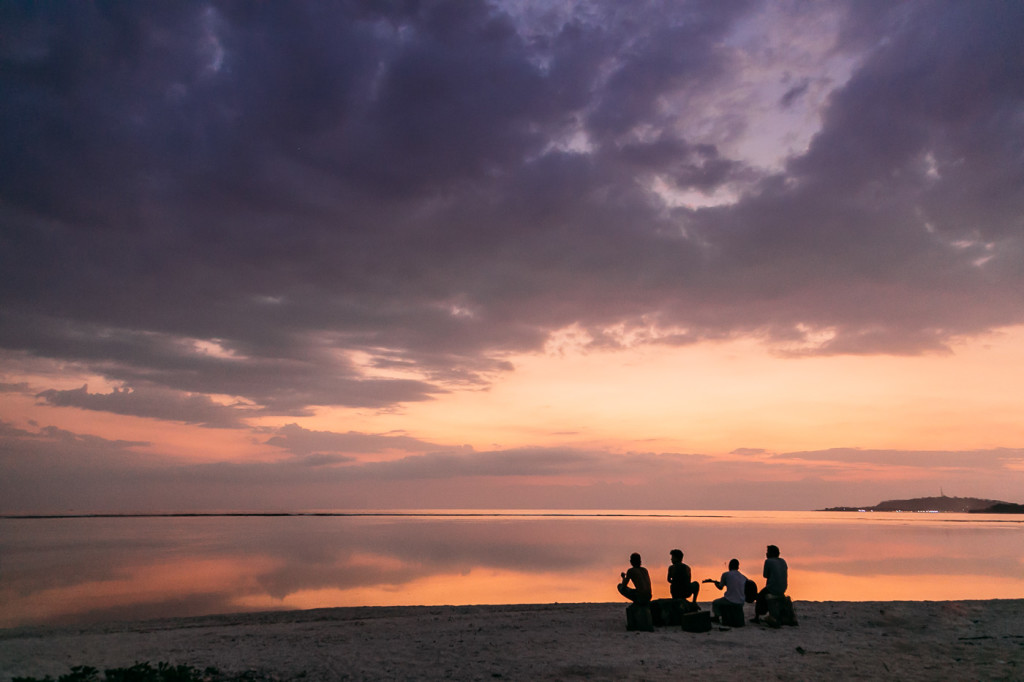 Why Gili Air?
Why Gili Air?
For us, scuba dive certification was long overdue. One of our biggest travel regrets was not being dive certified when we were in the Galapagos to swim with hammerhead sharks at Kicker Rock. So were committed to getting scuba dive certified once we landed in Southeast Asia.
The Gili islands are a fantastic destination for divers whether novice and scuba savvy. Those completing an Open Water Diver certification and diving for the first time will be comforted by the temperature of the water, short distance to get to dive sites around the islands, variety of marine life and high water visibility. More veteran divers will enjoy the technical drift dives, deeper depth shark sightings and ship wrecks.
Not to mention Gili Air is a completely laid back island where it’s easy to escape the world for a while. So long as you aren’t venturing here expecting to experience the real Indonesia (for that head to mainland Lombok or Java) there’s plenty of island charm here.
What to Expect from Your SSI Open Water Diver Certification
We metaphorically and literally dove right into our three-day Open Water Diver certification on the first day of our course. Just how we like it! Our instructor Max, a delightful frenchman with the perfect mix of seriousness and spunk from 3WDive, gave us an hour-long briefing going over the basics we had read in the study book the night before. Then it was masks, regulators and BC’s on and into the water.
A typical diving course, whether PADI or SSI, can be completed in three days here on Gili Air. You will have videos to watch, chapters to read and tests to take but the majority of your time will be spent in the water putting your new skills to practice. In addition to a few skills tests lead by your instructor during one of your four dives, there is one final multiple-choice test at the end before certificates are issued. But don’t stress this one too much – it is easier than it sounds.
Overview of Three-Day SSI OWC
Here’s a general guide as to what you can expect from a three-day dive course:
Day #1
Today is all about basic scuba skills training. By the end of today, you’ll be expected to show your instructor that you can partially clear your mask and remove and replace your regulator. After spending the morning going over fundamentals of diving and familiarizing yourself with the dive equipment (regulators, bcds, weights) it’s into the water. For some of the larger dive shops on the island this might mean training in a pool. But for 3WDive this means a short walk on the beach out into the great blue. While I found it slightly intimidating to start training in the ocean, I was later able to appreciate the real-world setting this forced me to get comfortable with.
Day #2
My favorite day! With the basic scuba skills out of the way, Day 2 is all about diving. Today you’ll head out on two dives around the Gili Islands based on the dive schedule for that day. You’ll continue to practice your underwater skills with your dive instructor during your dives. When you’re not in the water you’ll be finishing up quizzes in your book or watching videos. You’ll also learn how to assemble and dissemble all of your scuba equipment.
Day #3
It is another 2-dive day today which will be more fun and enjoyable now that you’ve gotten comfortable with your equipment and the idea of breathing underwater. During your dives your instructor will bring you to shallower depths to complete your remaining skills tests (like removing your mask underwater and clearing it completely, sharing secondary regulators with a buddy and replacing weight belts). Once you’re back on land it’s time to take the final written test.
That’s it! Your reward for three days of fun and hard work is an OWC cert card permitting you to buddy dive anywhere in the world independent of an instructor to a max depth of 18-meters. Now it’s time to start planning your advanced deep water dive cert!
Cost for an Open Water Dive Certification on Gili Air
Our SSI OWC course cost 4,400,000 IDR per person (US$330) per person (completed August 2015 with 10% online booking discount) with the option to add additional fun dives for between 400,000 IDR – 470,000 IDR (US$30 – $35) depending on how many you choose to purchase. It is worth noting that PADI certifications will run you slightly more as you have to purchase your reading materials outright instead of borrowing them. Certification costs typically will not include accommodation.
We ended up getting an SSI OWC because (a) that was all 3WDive offered and we really liked their style, and (b) we didn’t see the cost-benefit in purchasing the materials from PADI. We haven’t found there to be much of a difference between these two certifying agencies (or their teaching materials) and have been able to use our SSI cert without any issues at exclusively PADI dive shops. But you should go with what feels right to you.
Choosing a Gili Air Dive Operator for Your Open Water Diver Certification
Frankly, there are so many options when it comes to dive shops on the Gili Islands this made finding the right dive shop fit for our style and budget a daunting task.
Our first suggestion would be to identify which of the three islands suits your personality best because there are big differences between them. For Adam and I, Gili Air was the right mix of charm, chill, good food and social scene. We also liked that there was more of a local flair to Gili Air (albeit still overrun with scantily clad bikini wearing tourists) than on Gili Trawangan. Meanwhile Gili Meno felt too small and secluded for our tastes. Narrowing down which island you want to get certified on will immediately help limit the pool of operators.
Safety is always an important next consideration, especially when trying out new (and potentially life-threatening) adventures. We rely on TripAdvisor reviews from fellow travelers to make sure we end up with a company we can trust. Look out for what past clients have said about the condition of diving equipment (is it worn out? did they have issues with it during their course? did they have the right sized equipment?), number of students per instructor, and other general feelings regarding safety precautions of instructors.
In our search we found the prices generally to be the same between the shops on Gili Air, deviating by around US$20 for the entire course. As is typically our style, we went with a smaller Gili Air dive shop, more of an underdog, where we got excellent one-on-one attention with the dive masters and got to know all of the other travelers who were diving around the same time as us.
And it goes without saying you should look for a dive shop that speaks and can provide study materials in your native language. We were impressed with the range of languages spoken by dive shops around GiliAir. At 3WDive, instructors were available for English, French, German, Dutch and Bahasa native speakers.
Diving with Gili Air’s 3WDive Shop
Our three days of dive certification with 3WDive were exhausting, exhilarating and so rewarding. By the end we felt like we joined into a little (French) family on Gili Air, having spent most days diving with the same group instructors and clients. Our highly-experienced dive master Max was the perfect balance of collected calmness, infectious excitement and quirky humor to make our three day certification fun. We have truly missed diving with him on our subsequent dives at the USAT Liberty Wreck and HTMS Chang Shipwreck.
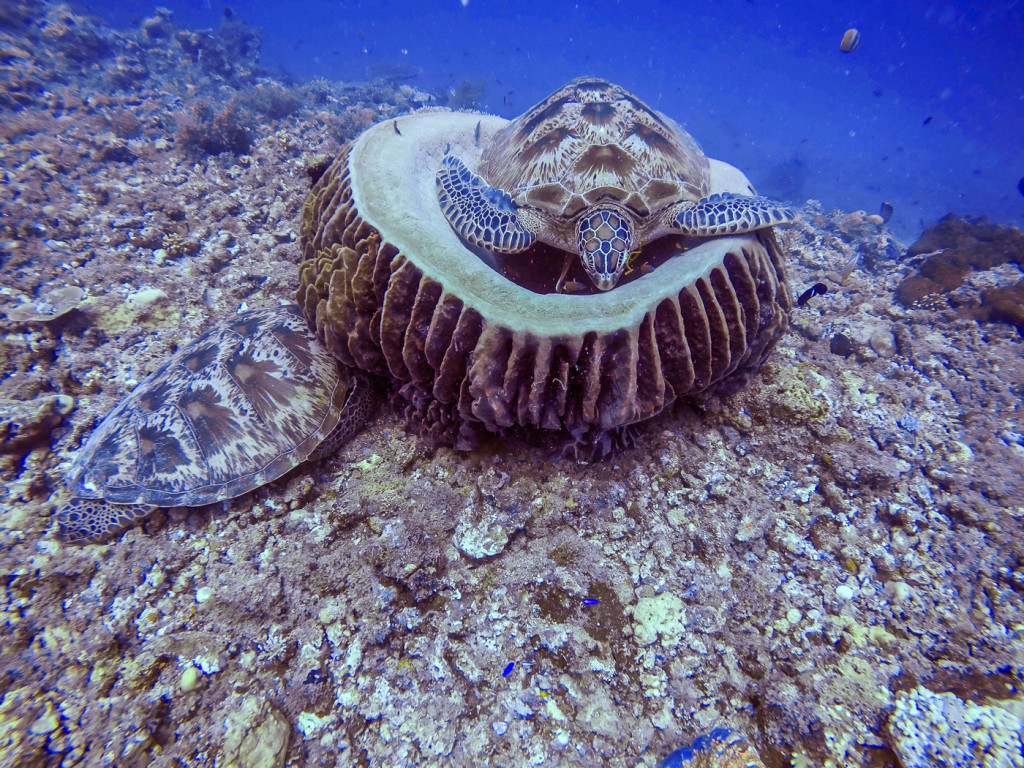 What You’ll See Diving Around the Gili Islands
What You’ll See Diving Around the Gili Islands
We’ll be the first to admit that our diving photos do not do the underwater life of the Gili Islands justice. For our first few dives after our course we were so focused on getting our skills down and breathing comfortably underwater our photography just wasn’t there yet. We also were relying solely on a GoPro Hero 4+ at the time which without the red filter does not shoot good photos at depths of 10-20 meters. We’ve since traded up to an underwater housing for our Canon G7X.
So instead of showing you, we’ll just have to gush for a minute about the diving we enjoyed while on the Gilis. Our favorite dive sites were Manta Point, Shark Point and Hans Reef. The gentle slopes of Manta Point led us to our first reef shark spotting! Although it was a sleeping shark we were still thrilled to have spotted one so quickly after learning to dive.
We also loved the clown triggerfish of Hans Reef with his dramatic coating of spots and stripes showed us his territorial nature as he defensively guarded his space.
Then there were the turtles. Sea turtles were in such an abundance around the Gili Islands during our diving they almost become a permanent (and dare I say mundane) fixture of the seascape. Collectively there were more than we’ve seen anywhere else – turtles under corals, on top of corals, swimming and eating – except for snorkeling Los Tuneles in the Galapagos.
The macro-life was also spectacular. The odd and always ugly frog fish have become my favorite scuba spotting and we saw more than a handful in our five dives on the Gilis. This, I would later learn, is not as common as I was led to believe while diving the Gilis. We also saw plenty of sea slugs, nudibranch, mantis shrimp, and blue ribbon eels.
Underwater Photography During Your Open Water Diver Certification
Your focus during your open water diver certification won’t be on snapping award-winning underwater photos of fish. But we get the desire to document your first experiences under the sea. Ask your dive instructor at what point she will be comfortable allowing you to take photos as it is a distractor from your skills training and some instructors outright won’t allow it until you’ve passed your OWC. Your dive shop also may have underwater photographers on staff who accompany you on dives to document your experience.
GoPro with Red Filter
GoPros are the most versatile underwater cameras for active travelers though unless you are getting right up close to your subjects the camera shoots too wide to produce solid photos. If you are bringing your GoPro consider investing in a red filter that will add back the red and orange tones you lose in the color spectrum when you are diving at depth. Also consider a selfie stick with strap or carabiner to attach the camera to your BCD so you can swim with both hands free if needed.
Point & Shoot + Underwater Housing
Another (pricier) option could be to buy an underwater housing unit for your point and shoot. This is what we’ve used to shoot Koh Haa and the Similan Islands and have been really happy with it. Flash, whether internal to the camera or as an added accessory is necessary to add color back that is lost at depth.
A Muck Dive for Good Measure
If you are looking for something a little different, ask your dive shop about muck diving off the coast of Lombok. Muck diving gets its name from the muddy or mucky sediment on the ocean bottom. Different types of marine life live in muck dive areas including a lot of interesting macro life. Muck dives are a good challenge for your buoyancy as well as you have to hover very close to the sea floor to see the macro life without touching your fins on the ocean bottom and causing a cloud of mucky sand that ruins visibility.
I’ll admit I’m not going to rush out to complete another muck dive anytime soon (I love the colorful corals and tropical fish too much) but it was definitely an interesting experience and gave us a new eye into life under the sea.
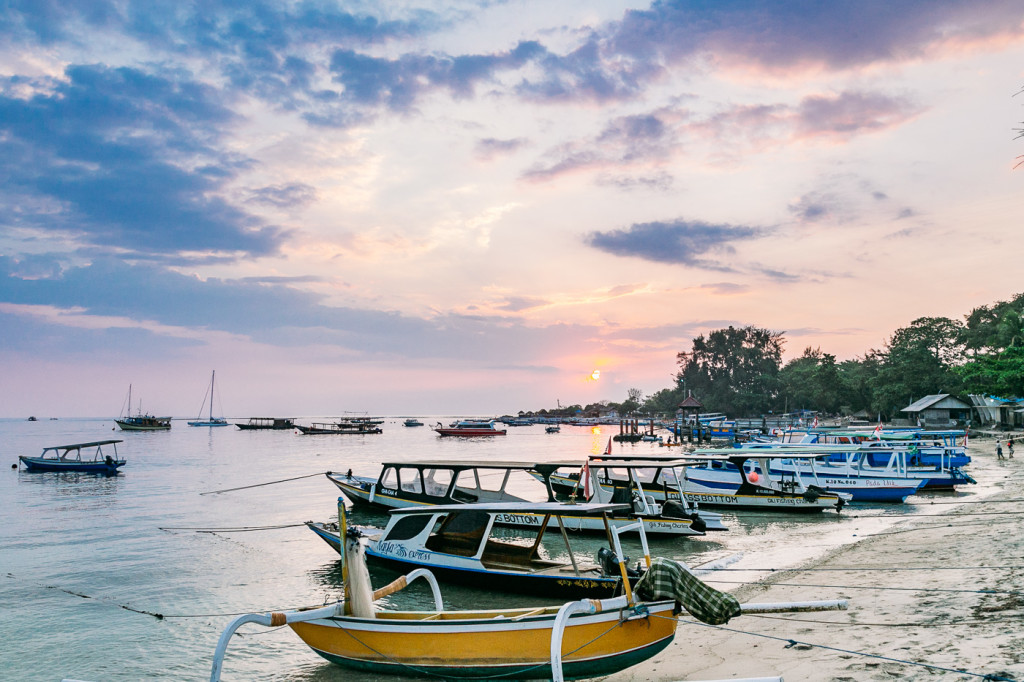 How to Get to Gili Air
How to Get to Gili Air
The simple answer is by fast boat (2+ hours) from Bali. (Boat operators will pick you up from your hotel almost anywhere in Bali and bring you to their port at either Padang Bai or Serangan.)
Of course if you have googled this at all you’ve likely found what’s simple in theory is much more difficult in practice on this one. There are too many scary boat operators out there and it is hard to weed through the horror reviews and dodgy Kuta travel agencies.
If you are are really stressing this boat trip opt for one of the more expensive operators like Gili Getaway, Gili Cat, Scoot or Blue Water Express. However, you’ll be paying for piece of mind. On our return trip to Bali we took a lesser known boat operator and while it wasn’t the same level of comfort as Gili Getaway it was less than half the price and we had no issues.
If you aren’t coming from Bali you can also fly into Mataram, Lombok then take bus to ferry transport to Gili Air. Just be aware of how your flight alings with the ferry schedule as you may not be able to make it to Gili Air on the same day you fly in.
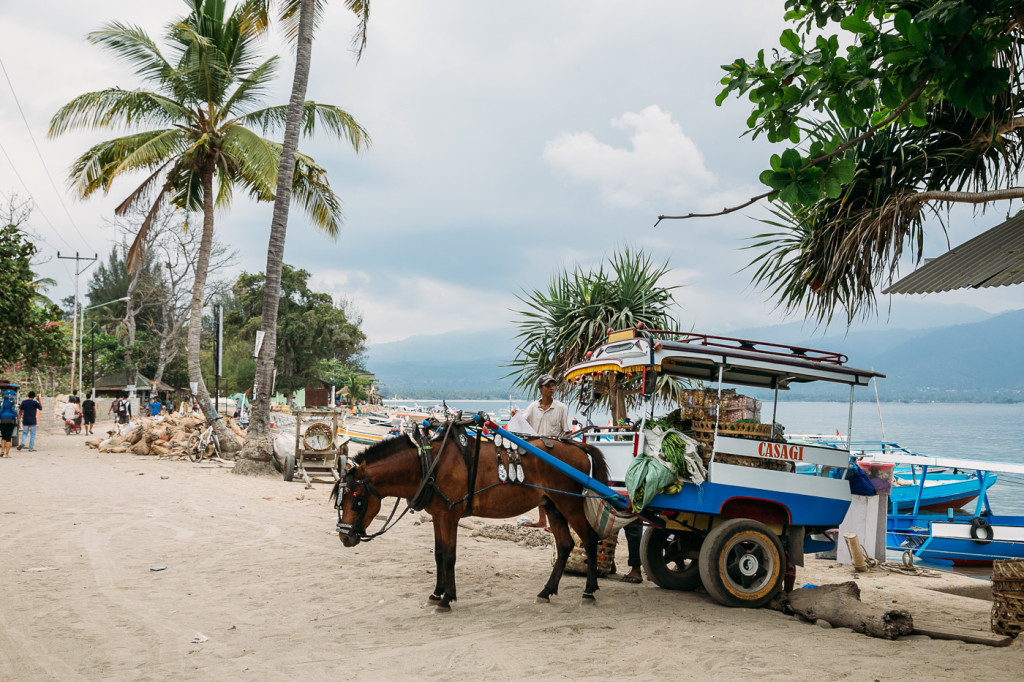 If You Go: Open Water Diver Certification Gili Air
If You Go: Open Water Diver Certification Gili Air
What: Learn how to scuba dive in one of Southeast Asia’s diving hot beds, the Gili Islands. Known for their warm, calming waters, high visibility and families of turtles, the Gili Islands continue to pull dive certification seekers away from Thailand’s Koh Tao. Gili Air is one of the three Gili Islands and offers visitors a chilled out vibe, plenty of tasty food options and the right mix of party and quiet.
Where: Gili Air is located off the coast of Lombok in Indonesia.
When: Many visitors to Indonesia try to avoid the rainy season which comes later than the rest of mainland Southeast Asia between November and April. However, if you are willing to brave the rains there are considerably fewer people and prices are generally cheaper. Plus, you’ll be in the water getting wet anyway!
Cost: Approximately 4,300,000 IDR – 4,900,000 IDR (US$320 – US$350) for a three-day open water dive certification course. Fun dives start around 405,000 IDR (US$30).


